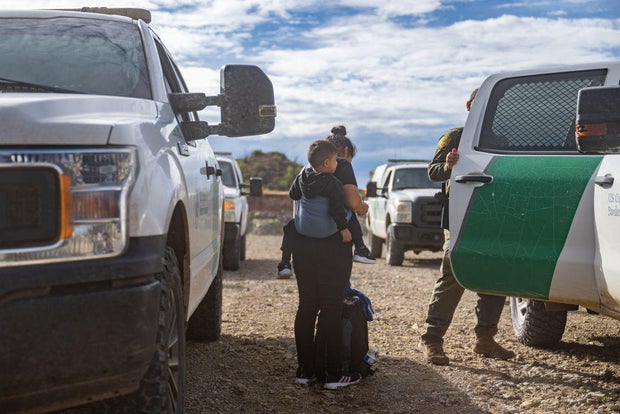Sasabe, Arizona — Unlawful crossings by migrants along the U.S. southern border dropped for the fifth consecutive month in July, plunging to the lowest level since the fall of 2020, internal government figures obtained by CBS News show.
U.S. Border Patrol agents made fewer than 60,000 migrant apprehensions between official points of entry along the U.S.-Mexico border in July, the lowest number since September 2020, when the agency reported 54,000 apprehensions, according to the preliminary Customs and Border Protection data.
In December, during a record-breaking spike in migration at the U.S.-Mexico border that overwhelmed agents in parts of Texas and Arizona, Border Patrol reported 250,000 apprehensions, or over four times July’s tally.
The marked reduction in border crossings in July continues a remarkable downward pattern in illegal immigration that started earlier this year. Border Patrol recorded 84,000 migrant apprehensions in June; 118,000 in May; 129,000 in April; 137,000 in March; and 141,000 in February, according to government statistics.
Those figures do not include entries at official border crossings, otherwise known as ports of entry, where the Biden administration is processing roughly 1,500 migrants per day through a phone app that distributes appointments to those waiting in Mexico.
While crossings have been declining for months, U.S. officials have attributed the steep decrease in illegal border crossings in recent weeks to a proclamation issued by President Biden in early June that has dramatically curtailed access to the overwhelmed U.S. asylum system.
“This is the product of a number of actions this administration has taken,” Homeland Security Secretary Alejandro Mayorkas said in an interview with CBS News this week. Those actions, Mayorkas noted, include “the president’s executive action, which restricted asylum in between the ports of entry, cutting out the smugglers.”
Migration to the U.S. border has dropped so markedly that the weekly daily average of daily illegal border crossings is inching close to the 1,500 threshold the Biden administration set to deactivate its asylum crackdown. In December, Border Patrol recorded roughly 8,000 illegal crossings per day.
Other factors have also played a role in the dramatic decrease in border crossings. At the request of the U.S., Mexican officials have overseen a large-scale crackdown on migrants over the past months, stopping many from setting foot on U.S. soil in the first place. The scorching summer temperatures have also made the migration trek even more treacherous.
Mayorkas credits Biden’s “decisive action”
Mr. Biden’s June proclamation has effectively shut down asylum processing between ports of entry, making it easier for U.S. immigration officials to more quickly return migrants to Mexico or their home countries if they enter the country illegally.
The policy change has led to a sharp drop in the number of migrants being released into the U.S. to await asylum hearings, federal statistics show. U.S. officials view those releases as “a pull factor” that induces migration as migrants who are released are typically allowed to stay in the country for years, even if their asylum claims ultimately fail, because the immigration courts’ ability to review applications in a timely fashion has been crippled by a backlog of millions of cases.
Under the new rules, U.S. officials are no longer required to ask migrants whether they fear being harmed if deported. And even if migrants express fear of being harmed, they are being referred for preliminary asylum interviews with much higher standards. Unaccompanied children and certain vulnerable groups are exempted from the asylum crackdown, which has also had a more limited impact on migrants from countries where the U.S. does not carry out deportations on a regular basis.
Mayorkas said the administration moved to restrict asylum unilaterally after a border security agreement brokered by the White House and a small group of senators earlier this year collapsed due to insufficient Republican support.
“Despite a bipartisan proposal, Congress failed to act, politics got in the way, and the president took the decisive action of his executive order,” he said.
While the administration has credited Mr. Biden’s executive action for the lower levels of illegal immigration, the move has garnered criticism from advocates who say it runs afoul of U.S. asylum law, as well as from Republican lawmakers who say the president only acted because of political concerns around immigration ahead of the election.
Mayorkas rejected that criticism, noting the administration has created several programs for migrants to enter the U.S. legally, including the app-powered border appointment system and a policy that allows Cubans, Haitians, Nicaraguans and Venezuelans to fly to the U.S. if they have American sponsors.
“The asylum system is open, the border is not,” Mayorkas said. “People need to take the lawful, safe and orderly pathways that we have developed. That is a matter not only of law enforcement, of border enforcement — that is a matter of humanitarian imperative.”
Restrictions on asylum are likely to continue in the next year, regardless of who wins the presidential election in November. Vice President Kamala Harris’s campaign manager recently signaled to CBS News that Harris would continue Mr. Biden’s asylum halt, while former Donald Trump has promised to reinstate his hardline border policies.


